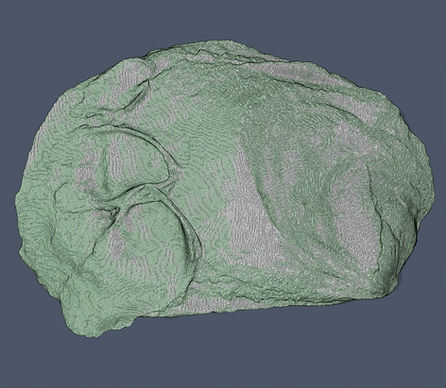
Restoring Habitat on Hardened Shorelines
Biomimicry Design Research Sponsored by Hyundai Motor Group
Project Duration: 3 Months, Commitment: Part-Time, Years: 2024
Background:
Habitat loss is one of the top two most significant human threats to marine environments. Human structures that interface with marine environments for purposes such as coastal defense as well as industrial and residential infrastructure can cause maritime habitat loss and reduce ecological connectivity. What if we found a way to increase effective cohabitation of humans and maritime wildlife in the context of reimagining these structures? This was my design research question for my Rhode Island School of Design (RISD) course, SCI-1116-01: The Language of Design in Nature - Future Structures, sponsored by Hyundai Motor Group (HMG). My research focused on Eastern Oyster reef ecosystems and hardened shorelines. Oyster reefs are known to reduce wave energy and prevent erosion on coastlines, but unfortunately human structures like sea walls and breakwaters, meant to protect coastlines from the same threats, harm oyster habitats. At least 85% of oyster reefs have died off around the world.
Systems:
I analyzed the systematic human threats to oyster reef success including substrate loss, pollution, and changes in hydrodynamics and sediment build-up patterns, as shown in the below summary diagram I created.
.jpg)
Specimen:
I also carried out an analysis of large and small scale oyster/oyster reef textures and growth patterns as well as their shell and adhesive calcium carbonate materials.
High-resolution, focus-stacked photos I took of RISD Edna Lawrence Nature Lab collection oyster shell growth patterns using RISD’s Macropod Imaging System
Still images of 3D Models of RISD Edna Lawrence Nature Lab collection adult oyster shells hosting juvenile oyster shells I captured using RISD’s Artec Spider 3D Scanner

Eastern Oyster Reef Structure (seafoodsource.com)
The structure of porous coral reefs was also referenced for its relation to slowing wave forces.

CT scan of a Scleractinia “stony coral” porous structure (Laforsch et al., 2008).
Design:
As part of this research, I rendered some designs for augmenting hardened coastal structures to encourage oyster reef ecosystem success while still protecting the shoreline:
1) Oyster reef-mimetic sea wall augmentation design:
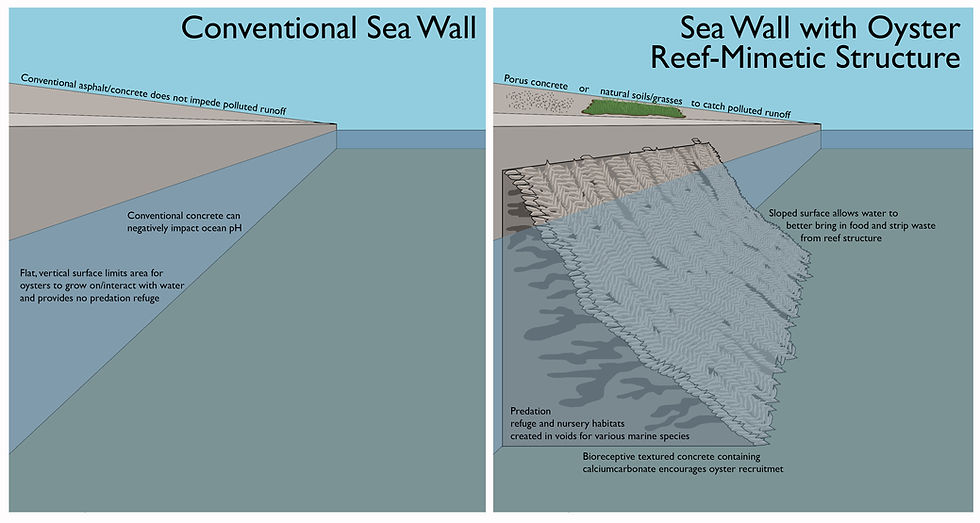
Preliminary design for an oyster-reef mimetic sea wall attachment that could be installed to encourage oyster growth in an area where oysters used to thrive before the sea wall was installed and reduced the amount of suitable substrate for oysters to grow on. It also provides guidance for mitigating polluted runoff. This structure could be taken into account when building new coastal structures, however, the goal of this design would be a modular structure that can be installed onto pre-existing hardened shoreline infrastructure. Its adherence would have to be chemically stable and its installation as non-invasive as possible to the existing ecosystem.
2) Coral-mimetic porous breakwater design:


Preliminary design for a coral-mimetic porous breakwater that could be installed to mitigate downstream water and siltation damage to coastlines and marine life like oyster reef ecosystems. This structure would also be made of bioreceptive materials so marine life could make habitat in and around it.
Design Process:
RISD Biomimicry Design Helix:
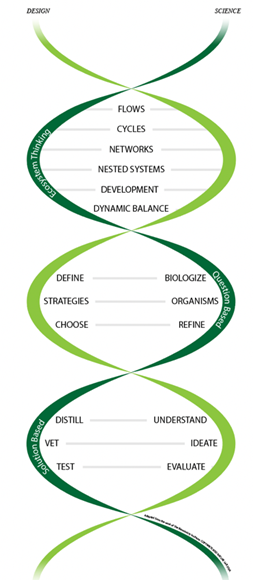
Expert Interviews:
To support my design research, I interviewed professionals from the following organizations:







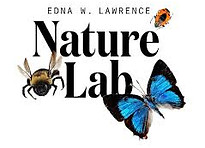
Early Concept Sketches:
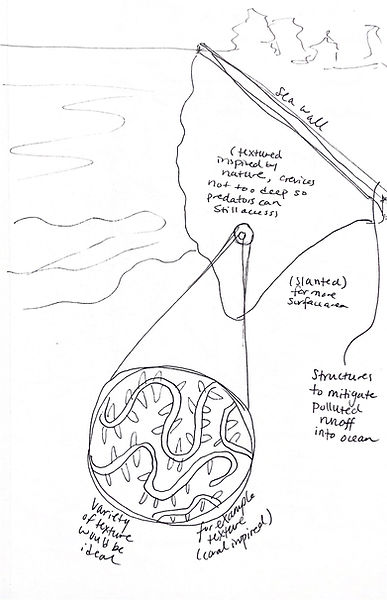

Reflection:
Restoration projects often face challenges due to an incomplete understanding of the complex ecological systems they aim to restore, underscoring the importance of identifying specific sites and evaluating their unique needs rather than applying generic solutions. In order to continue this research, a suitable site would need to be identified and assessed for present oyster reef threats, in collaboration with local ecology experts, to determine which design approach is most appropriate. Then we would conduct deep research into specifications, materials sourcing (including potential use of local waste streams), hydrodynamics, and structural modeling. Next, we would undergo lab followed by onsite prototype testing and evaluate its performance—such as larval settlement and wave mitigation—against restoration criteria. Finally, we would share findings addressing ecological, technical, and socio‑institutional factors to enhance the success of future multidisciplinary human-nature design applications.
References:
Baggett, L.P., S.P. Powers, R. Brumbaugh, L.D. Coen, B. DeAngelis, J. Greene, B. Hancock, and S. Morlock, 2014. Oyster habitat restoration monitoring and assessment handbook. The Nature Conservancy, Arlington, VA, USA., 96pp.
Bishop, M.J., Mayer-Pinto, M., Airoldi, L., Firth, L.B., Morris, R.L., Loke, L.H.L., Hawkins, S.J., Naylor, L.A., Coleman, R.A., Chee, S.Y., & Dafforn, K.A. (2017). Effects of ocean sprawl on ecological connectivity: Impacts and solutions. Journal of Experimental Marine Biology and Ecology, 492, 7-30. https://doi.org/10.1016/j.jembe.2017.01.021
Burkett JR, Hight LM, Kenny P, Wilker JJ. Oysters produce an organic-inorganic adhesive for intertidal reef construction. J Am Chem Soc. 2010 Sep 15;132(36):12531-3. doi: 10.1021/ja104996y. PMID: 20722392.
Crain, C.M., Halpern, B.S., Beck, M.W. and Kappel, C.V. (2009), Understanding and Managing Human Threats to the Coastal Marine Environment. Annals of the New York Academy of Sciences, 1162: 39-62. https://doi.org/10.1111/j.1749-6632.2009.04496.x
Ferrario, F., Beck, M., Storlazzi, C. et al. The effectiveness of coral reefs for coastal hazard risk reduction and adaptation. Nat Commun 5, 3794 (2014). https://doi.org/10.1038/ncomms4794
Gittman, R.K., Fodrie, F.J., Popowich, A.M., Keller, D.A., Bruno, J.F., Currin, C.A., Peterson, C.H. and Piehler, M.F. (2015), Engineering away our natural defenses: an analysis of shoreline hardening in the US. Frontiers in Ecology and the Environment, 13: 301-307. https://doi.org/10.1890/150065
Heery, E.C., Bishop, M.J., Critchley, L.P., Bugnot, A.B., Airoldi, L., Mayer-Pinto, M., Sheehan, E.V., Coleman, R.A., Loke, L.H.L., Johnston, E.L., Komyakova, V., Morris, R.L., Strain, E.M.A., Hemraj, D. A., Bishop, M. J., Hancock, B., Minuti, J. J., Thurstan, R. H., Zu Ermgassen, P. S. E., & Russell, B. D. (2022). Oyster reef restoration fails to recoup global historic ecosystem losses despite substantial biodiversity gain. Science advances, 8(47), eabp8747. https://doi.org/10.1126/sciadv.abp8747
Law, David & Evans, Jane. (2013). Effect of Leaching on pH of Surrounding Water. Magazine of Concrete Research. 110. 291-296.
Kay, C. A. M., Rohnke, A. T., Sander, H. A., Stankowich, T., Fidino, M., Murray, M. H., Lewis, J. S., Taves, I., Lehrer, E. W., Zellmer, A. J., Schell, C. J., & Magle, S. B. (2022). Barriers to building wildlife-inclusive cities: Insights from the deliberations of urban ecologists, urban planners and landscape designers. People and Nature, 4, 62–70. https://doi.org/10.1002/pan3.10283
Laforsch, C., Christoph, E., Glaser, C. et al. A precise and non-destructive method to calculate the surface area in living scleractinian corals using X-ray computed tomography and 3D modeling. Coral Reefs 27, 811–820 (2008). https://doi.org/10.1007/s00338-008-0405-4
Woosug, Cho. (2022). National Atlas of Korea. http://nationalatlas.ngii.go.kr/pages/page_3080.php
NOAA Fisheries. (2022). Oyster Reef Habitat. https://www.fisheries.noaa.gov/national/habitat-conservation/oyster-reef-habitat
NOAA Fisheries. (2024). Eastern Oyster. https://www.fisheries.noaa.gov/species/eastern-oyster
NOAA Fisheries. (2024). Pacific Oyster. https://www.fisheries.noaa.gov/species/pacific-oyster
Naylor, L.A., & Dafforn, K.A. (2017). Identifying the consequences of ocean sprawl for sedimentary habitats. Journal of Experimental Marine Biology and Ecology, 492, 31-48. https://doi.org/10.1016/j.jembe.2017.01.020
Park, B.H., Park, Kim, B.Y., Hur, S.B., & Kim, S.J. (1989). Culture of the Pacific oyster (Crassostrea gigas) in the Republic of Korea. https://www.fao.org/4/ab706e/AB706E00.htm#TOC
Poor, Cara, Kaye, Jackson, Struck, Rodney, & Gonzalez, Ruben. (2023). Permeable Pavement in the Northwestern United States: Pollution Source or Treatment Option? Sustainability, 15(17), 12926-. https://doi.org/10.3390/su151712926
Rice, Michael. (2006). A Brief History of Oyster Aquaculture in Rhode Island. 10.13140/RG2.1.2001.7683.
Tiersma, Maaike. (2016). Oyster Aquaculture in Rhode Island: 1912 to present. https://drive.google.com/file/d/1adBRx0-nBWJ3sbJd0i3LD0PKGqPeFigS/view




